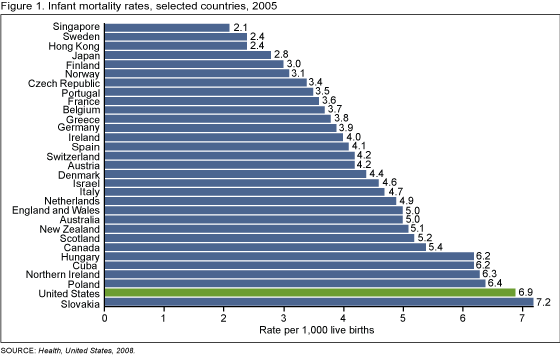
America is a great superpower of the world. In its short history, America has taken one of the greatest, if not the greatest, positions in the world as the establisher of modern culture and policy. The United States is a worldwide symbol of opportunity, education, and progress. The mighty American media has unquestionably molded the lives of millions, if not billions, of people around the world. People have designed their lifestyle based on the over-exposed personal lives of a small handful of American celebrities. America’s “greatness” is clearly displayed in the widespread level of wealth and prosperity among its citizens, especially when compared to the rest of the world. With the average median income of Americans being $32,000 per year (U.S. Census Bureau, 2006), most Americans, even those who fall under the median income level, enjoy high standards of living when compared to a majority of other citizens of the world. American life is generally cushioned with a home, a job, a car, a school, and a Target. There are supermarkets, clean water, toilets and sanitation systems, franchised shopping stores, community activities and entertainment. Doctors and healthcare professionals are conveniently available at any moment in a local hospital or urgent care center. Modern technology and medicine provides a pill or surgery for almost every ache, pain or disease, and death is almost always avoidable if you can get to the hospital in time, unless the death is due to a tragic accident or a seriously “bad” life choice. The government is there to ensure that this American lifestyle can be sustained. You can vote and you can believe that your vote will be heard, and if necessary, you have the freedom to join in groups and protest against social wrongdoing. It’s the American Dream, and it is apparently real.
America, in all its greatness, is supposed to be a place where all can be healthy and have healthy babies. The reality is that this is a myth. America is not a great nation of health and is not a land of healthy living babies. In fact, the statistics paint a strikingly different picture. According to the Center for Disease Control, the infant mortality rate, the rate at which babies less than one year of age die, has continued to steadily decline over the past several decades, from 26.0 per 1,000 live births in 1960 to 6.75 per 1,000 live births in 2007 (Xu, Kochanek, Murphy, & Tejada-Vera, 2010). This may seem like an encouraging statistic, but I would suggest that it’s not enough because the United States still only ranked 25th in the world in infant mortality in 2005 (MacDorman & Mathews 2009). Over 2,500 deaths occur in the United States every year due to Sudden Infant Death Syndrome, or SIDS (Peterzell, 2009). We may be saving more babies and mothers now, but we are still doing things wrong if our great nation ranks so poorly compared to almost all other civilized nations.
(http://www.cdc.gov/nchs/data/databriefs/db23.htm#ranking)
The CDC reports that 26.6 million Americans, or twelve percent, have been diagnosed with heart disease (Pleis, Lucas & Ward, 2009). 616,067 Americans died of heart disease in 2007, making heart disease the number one cause of death in America. In 2009, about 1,479,350 new cancer cases are expected to be diagnosed, with 562,340 expected to die of cancer, or more than 1,500 people per day. Cancer is the second most common cause of death in the US. In the United States, cancer accounts for nearly one of every four deaths. Most cancer cases occur in adults who are middle-aged or older. About seventy-seven percent of all cancers are diagnosed in persons fifty-five years and older (American Cancer Society, 2009).
Obesity, a major risk factor for cardiovascular disease, certain types of cancer, and type 2 diabetes, has dramatically increased in the last twenty years in America. Thirty-three states had a prevalence of obesity equal to or greater than twenty-five percent, with nine of these states (Alabama, Arkansas, Kentucky, Louisiana, Mississippi, Missouri, Oklahoma, Tennessee, and West Virginia) having a prevalence of obesity equal to or greater than thirty percent of the population (Center for Disease Control, 2009). Obesity is a serious health concern for children and adolescents. Results from the 2007-2008 National Health and Nutrition Examination Survey (NHANES), using measured heights and weights, indicate that an estimated seventeen percent of children and adolescents ages two to nineteen years old are obese (Center for Disease Control, 2010).
According to the American Diabetes Association, 23.6 million children and adults in the United States—7.8% of the population—have diabetes. Diabetes was the seventh leading cause of death listed on U.S. death certificates in 2006. According to death certificate reports, diabetes contributed to a total of 233,619 deaths in 2005, the latest year for which data on contributing causes of death are available, making diabetes the seventh leading cause of death in the United States. (American Diabetes Association, 2010). Once considered an environmental disease that occurred during adult hood, type-2 diabetes, or adult-onset diabetes, is now becoming an autoimmune disease that children are being born with.
Finally, in 2007, suicide was the tenth leading cause of death in the U.S., accounting for 34,598 deaths. The overall rate was 11.3 suicide deaths per 100,000 people. An estimated eleven attempted suicides occur per every suicide death. (National Institute of Mental Health, 2010).
These grim statistics are easily available for any American to discover. Evidence-based answers to why these diseases are more and more prevalent are less available, at least without much controversy and opinion surrounding them. Many families are realizing that they must do something to change these statistics. They are actively searching and finding that there are simple changes they can make in their lives to dramatically reduce their chances of becoming a statistic, such as preparing for conception to promote healthier reproduction, consuming and using toxin-free food and home products, and practicing traditions in diet laid forth by centuries of ancestral wisdom that most of modern culture rejects. But most American families see these statistics and abandon their worries to the mystery of it all, hoping and praying that it just doesn’t happen to them. There is little understanding or belief that efforts they make can reduce most of these health risks. They continue to reproduce and raise their families unchanged and unknowingly guided by the modern corporate agenda.
A typical American woman might one day begin to feel a little funny, or different. She thinks about the “happenings” of the previous month and decides to pick up a pregnancy test at the supermarket or drugstore. Seeing a pink plus sign invokes one of the greatest emotional explosions of life. Regardless of her feelings about the idea of having a baby, she immediately is a mother. At some point she makes her way into an Obstetrician’s office. She is given a prenatal vitamin prescription and sets up many appointments for ultrasounds and possibly an amniocentesis, genetic testing, third-dimensional ultra-sounds or other intrusive tests. The mother is told what hospital she will be having their baby in and the list of hospital classes and tours they might consider attending. She finally leaves with a prize package of pregnancy magazines, an official pregnancy book from the American College of Obstetricians and Gynecologists, coupons and samples of synthetic prenatal nutrients, baby formulas and more. The mother begins to think about all the childbirths she’s seen on television shows and movies, and might start watching reality television shows about women having babies. Over the next few months, the nursery room is designed, baby showers are enjoyed, childbirth classes are attended, and a fear of the impending torture of childbirth begins to culminate. For this is this way women have always done it- at least since the “enlightenment” of the modern age, the woman rationalizes. How lucky we are to have modern maternity care instead of the uncivilized way we used to do it.
The truth is that American childbirth, family, and health culture has gone through a complete metamorphosis in the last one or two centuries, molded by modernization and industrialization. These elements of life were generally consistent throughout the world for most of documented history before this industrial change. There is an important question that remains, though: Are we really doing things better now? Though most of the world has been greatly influenced by modernization and industrialization, an understanding of primitive and traditional cultures may still be vital in discovering valuable life skills and practices handed down through centuries of ancestral wisdom. How has modernization molded the culture of American family life and health? Does such a culture even exist, or has it become a culture completely ruled by consumerism? Are we really smarter than past generations? What do we need to discover from the past in order to effectively and beneficially change our modern culture and future?
Though C.S. Lewis’ idea of “Chronological Snobbery” mainly pertained to his life ministry of sharing and defending the Christian faith, his cultural conclusions are entirely relevant to understanding and analyzing the current climate of American birth, family and health culture. In fact, as Lewis suggests, we need the perspective of the past to have a meaningful perspective of the present.
Next post in this blog series (coming soon): Reclaiming the Family: Childbirth History Part 1
Previous post in this blog series- Reclaiming the Family: Introduction


